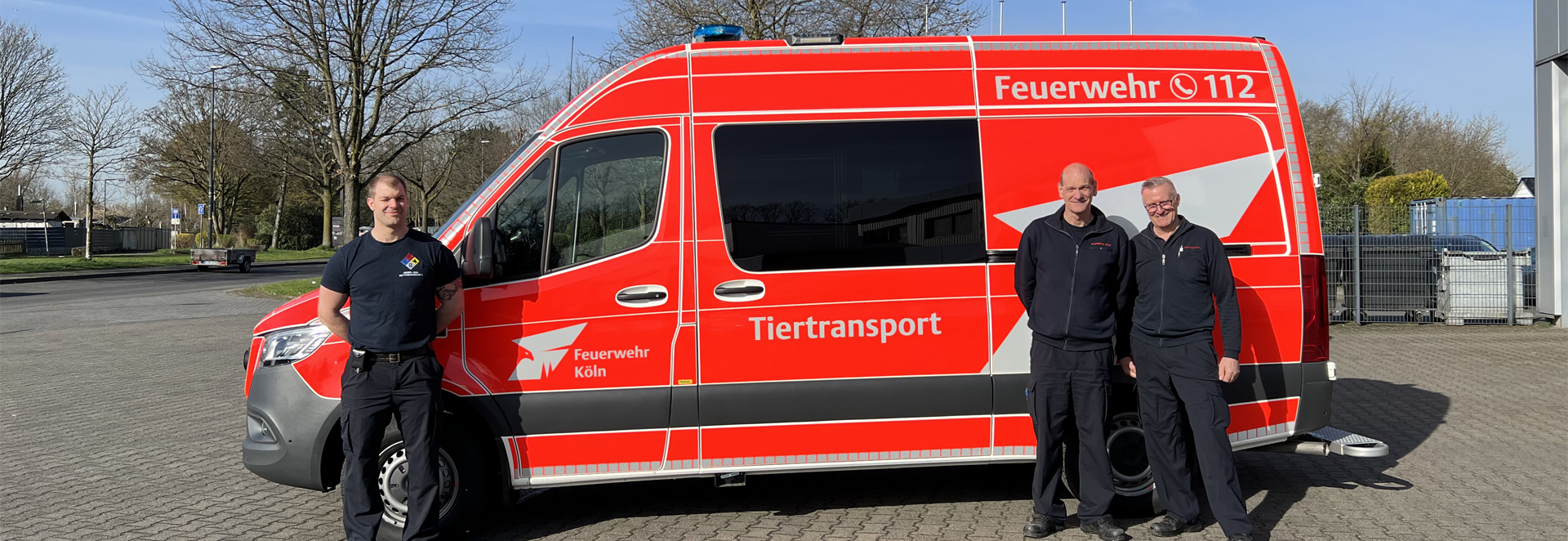


A boa constrictor at a dredge hole, six bats in the bedroom of an attic flat, a runaway dwarf pony on a road crossing - the reasons for using the WAS 900 animal transport vehicle are as varied as the fauna of the Rhineland. But who would have thought that the vehicle with the highest annual mileage at the Cologne Fire Brigade would be an animal transport vehicle? Most of the kilometres do not come from such unusual missions, however: as a rule, the emergency services are more often called upon to deal with domestic animals and less exotic wild animals.
When a person experiences a health emergency, the dog or cat should not be left behind without care. Often, members of the rescue services are the first on the scene because they have been called via the emergency system. In Cologne, a team from fire station 8 in Cologne Ostheim is then called to pick up the pet and take it to the animal shelter, where it is first taken in and cared for. For similar missions, the Cologne fire brigade has had a Mercedes-Benz Sprinter converted into an animal transporter by WAS. In summer, when more people are out and about and more animal emergencies are logged, the vehicle can be in use for 20 hours within a single 24-hour shift, covering 300,000 kilometres in six years.
A transport vehicle, not an animal ambulance.
When animals are kept without a permit or under unacceptable conditions, the WAS 900 animal transport vehicle goes out in response - just as it does when injured or stray animals are reported. Even then, however, the focus is on transport rather than medical care. Injured domestic animals are taken to the nearest veterinarian, while the respective district forester is responsible for injured wild animals. Of course, the emergency services will not abandon the owner of a dachshund stuck in a foxhole (for example), but it is important not to give the public the impression that the vehicle is some kind of emergency ambulance for animals. The focus of fire brigade operations is still on the welfare of humans, which is why it is often also a matter of preventing dangers posed by animals. This is the case, for example, if a dog‘s misguided protective instinct means that the rescue service cannot get near to their human patient in the first place. In one specific case, a dog owner had suffered a heart attack and his dog tried to protect him with all its might. The aggressive animal eventually had to be anaesthetised so that the rescue forces could work safely.
From cats in trees to ponies on crossroads.
The fire brigade being called to rescue a cat from a tree is an often repeated scene in films and on television. In real life, too, such reports are received by the control centre via 112. The control centre decides whether an operation is justified. Often, however, the animal team first takes a look at the scene to decide how to proceed. Experience shows that a cat that likes to climb will usually free itself if it is given some time and rest. If danger is imminent, the team must of course act immediately. One reason for acting quickly, for example, would be a runaway animal endangering road traffic. In such contexts, sheep (or the dwarf pony mentioned above) have been caught and taken away. Often, very small animals may have chosen the wrong place for their adventures. Then it‘s just a matter of returning them to a safe place. For example, the team transported six bats that had made themselves at home in the bedroom of a newly converted attic flat in the centre of Cologne. They were caught with a landing net and released many kilometres away in the hope that they would not find the flat again, because bats tend to return to the same shelter.
Perfectly normal firefighters.
Firefighters require empathy and nerves of steel to do their job, and the WAS 900 animal transport vehicle does not require any specialist training - the staff are simply standard firefighters. Most knowledge is passed on from older colleagues to younger ones. They all drive missions with the animal transport vehicle in addition to their 'normal' missions in the fire brigade, on the turntable ladder, in the water tender, or in the ambulance. Animal transport is only a small part of their wide range of tasks, but there are various training courses with experts on how to deal with aggressive dogs or injured birds of prey. In cooperation with Cologne Zoo, further training on the subject of reptiles is also available.
The trained firefighters on the crew of the animal transport vehicle are very good at assessing when expert advice is needed. This was the case when a 2.5-metre-long boa constrictor was spotted at the Baggerloch in Weidenpesch, for example. After consultation with a reptile specialist, the king boa was captured by the firefighters and placed in expert care in a special reptile box, which is part of the standard equipment of the vehicle.
Equipped for all eventualities.
In addition to the reptile box, the animal transport vehicle is also equipped with snares, blowpipes, leashes and many other devices for capturing and transporting a wide range of animals. Two built-in mesh boxes for accommodating dogs and cats still leave enough space for animals with the height of a pony. The equipment also includes fresh water and, of course, all kinds of food and treats.






No Comments